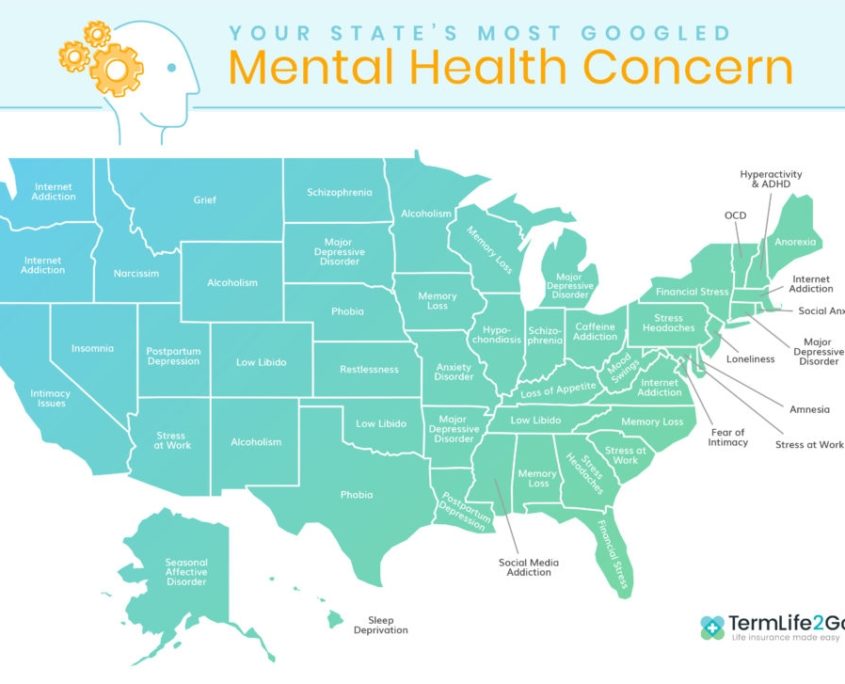Which mental health concerns do people worry about most in the United States? Why do we stress, and what do we stress about?
According to a recent study, more fellow Americans consistently suffer from mental and emotional distress. Unfortunately, many of them are unable to access adequate treatment, in spite of governmental efforts over the last 10 years to reduce such gaps in coverage.
The journal Psychiatric Services has analyzed interview data from census interviews and in 2017 estimated more than 3 percent of the U.S. population (in excess of 8 million Americans), suffer from what’s known as serious psychological distress (SPD). The term has been used to define feelings of worthlessness, despondency, and sadness dangerous enough to interfere with someone’s overall well being. Before the Psychiatric Services study, surveys have gauged SPD at around less than 3 percent.
SPD is more of a colloquial term than a medical diagnosis, though it overlaps significantly with clinical conditions like depression and anxiety. The survey consists of six questions, posed to participants in conjunction with an annual general health survey that the Centers for Disease Control and Prevention (CDC) conduct. Every year the survey reaches over 35,000 households nationwide, and over 200,000 adults from several socioeconomic backgrounds.
Let’s discuss the implications.
Mental Illness in the U.S.
Research continues to indicate that reliable mental illness predictors remain difficult to pinpoint, even for common disorders such as depression. One factor that seems to lead many Americans into feeling depressed and anxious is an excess of free time with relatively few pressing demands. Interestingly, people in less-developed countries are generally less depressed overall than we are in the U.S. For people in different parts of the world who are frequently in “survival mode,” dwelling on depressive feelings seems to take a back burner to more urgent demands. Based on this finding, one might argue that we’re “too comfortable”!
Over any given year, as many as 27 percent of American adults will go through some sort of mental health issue, making the U.S. the country with the highest prevalence of mental illness. Such disorders include anxiety disorders, attention deficit/hyperactivity disorder, mood disorders, and substance abuse.
During a typical lifetime, the average American has a 47.4 percent chance (nearly one in two people) of having any kind of mental health disorder. For projected lifetime prevalence, the odds are stacked even higher: for those who reach age 75, chances can go as high as 55 percent.
What are the Most Common Mental Illnesses in the U.S.?
Mood disorders, including bipolar disorder, dysthymic (persistent depressive) disorder, and major depression are the most prevalent mental illnesses in the U.S.:
- 7 percent of adults will experience one of these disorders during a given year, and over 21 percent will experience one of them during a lifetime.
- Women are 50 percent more likely to suffer from mood disorders than men.
- About 19 percent of all American adults will go through some sort of anxiety disorder this year, but this number jumps to around 31 percent during a lifetime.
Mental Illness Continues to be a Problem
What mental health issues are people in your state most concerned about? That depends upon where you live.
The modern “American” lifestyle involves “burning the candle at both ends” : constant stimulation, working overtime, and “keeping up with the Joneses: all continue to be formidable challenges for those struggling with mental health issues. As awareness increases, we turn to the one source of information we feel we can rely upon: Google.
There is an abundance of information available online, and it continues to be important to review as information from as many perspectives as possible. It’s also helpful to seek expert opinion when necessary.
What Credible Mental Health Sites Indicate
Life insurance provider TermLife2Go accessed mental health-related sites such as MentalHealth.gov and the National Alliance on Mental Illness (NAMI) to compile a list of the most common mental health conditions researched on Google, along with corresponding symptoms and stressors. The results were later run through Google Trends to pinpoint mental health concerns by state around the country between 2018 and 2019.

Image courtesy of TermLife2Go
Some Discoveries
Right off the bat, major depressive disorder, internet addiction, and memory loss tied for the most Googled mental health concerns in America.
Other findings include:
- Arizona, Maryland, and South Carolina were concerned about “stress at work,” while those in Georgia and Pennsylvanians researched “stress headaches.”
- “Seasonal affective disorder” was the most Googled concern in Alaska, where days at a time can pass in the wintertime without even a glimpse of the sun.
- Utah and Louisiana were wanting to know more about postpartum depression. As for Utah, the CDC typically ranks the state in the top ten for highest birth rates.
- Massachusetts, Oregon, Virginia, and Washington worried about possible internet addiction, while Missouri was concerned about social media habits.
- Alcoholism is the top mental health concern for those in Minnesota, New Mexico, and Wyoming.
Moving Forward With Your Mental Health Management
Do your research and find out what you can about managing mental illness if you need to. Individuals can manage many mental health issues, but often they become overwhelming and seemingly unmanageable. This is when you might seriously consider seeking out a mental health professional.
What are your biggest mental health concerns? Leave us a comment below!
What is the latest regarding your mental health? Always remember that it is very treatable and manageable. If you or someone close to you need to talk to someone about mental health issues that seem overwhelming, we can help. Consider reaching out to our expert team at Solara Mental Health at 844-600-9747.

